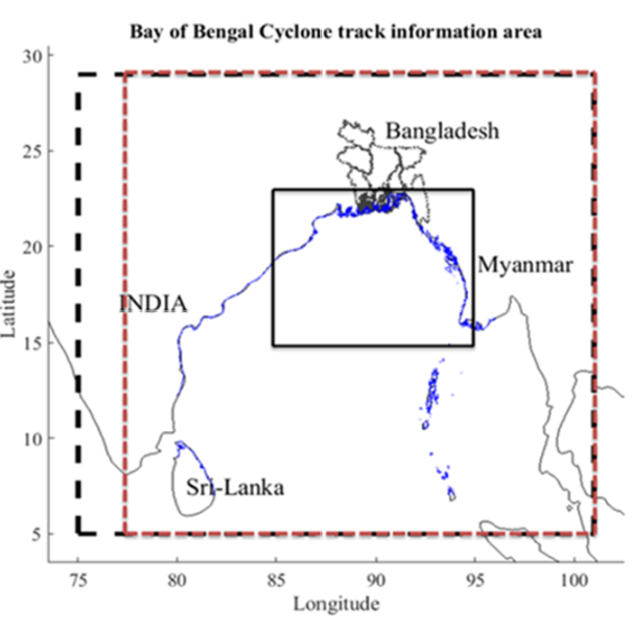Effect of Coriolis Force on the Numerical Estimation of Water Level Elevation Due to a Catastrophic Cyclone along the Coast of Bangladesh
DOI:
https://doi.org/10.56532/mjsat.v2i3.71Keywords:
Bangladesh, Coast, Coriolis, FDM, TideAbstract
A two-dimensional vertically integrated shallow water equation in the Cartesian coordinate model is used to estimate the water level considering the impact of Coriolis force. The shallow water model equation was discretized by a finite difference method (FDM). Consider the forwarding of time and central space as a moderator of this discretization. The model approximates coastal boundaries, small islands, small rivers and complex tributaries by an accurate stair step representation. The model equations are solved by a static semi-implicit finite difference technique where a structured Arakawa C-grid system is used as the condition. A one-way nested scheme technique is used to incorporate complex land-sea interfaces such as small offshore islands and water depths with sufficient accuracy as well as decreasing the computational cost. A stable tidal condition was created by applying M2 tidal forcing with the largest tide along the southern open boundary of the Bay of Bengal. The model uses the Coriolis force as an external force that can affect water buoyancy. The main task is to analyse the effect of Coriolis force on water buoyancy. The described model was applied to simulate sea-surface elevation associated with the severe cyclone in April 1991 that strike on the east coast of Bangladesh. We have found a significant impact of Coriolis force on surge height. However, the model gives an accurate numerical estimate of surge height.
References
M. M. Rahman, A. Hoque, G. C. Paul, and M. J. Alam, “Nested Numerical Schemes to Incorporate Bending Coastline and Islands of Bangladesh and Prediction of Water Levels due to Surge,” Asian J. Math. Stat., vol. 4, no. 1, pp. 21–32, Dec. 2010, doi: 10.3923/AJMS.2011.21.32.
M. A. Al Mohit, M. Yamashiro, N. Hashimoto, M. B. Mia, Y. Ide, and M. Kodama, “Impact assessment of a major river basin in Bangladesh on storm surge simulation,” J. Mar. Sci. Eng., vol. 6, no. 3, p. 99, Aug. 2018, doi: 10.3390/JMSE6030099.
M. A. Al Mohit and M. Towhiduzzaman, “A numerical estimate of water level elevation due to a cyclone associated with a different landfall angle,” Sains Tanah, vol. 19, no. 1, pp. 33–41, Mar. 2022, doi: 10.20961/stjssa.v19i1.56600.
A. A. Mohit, Y. Ide, M. Yamashiro, and N. Hashimoto, “A comparative study of two different numerical methods on storm surge,” Proc. 9th Int. Conf. APAC 2017, no. 213039, pp. 163–174, 2018, doi: 10.1142/9789813233812_0016.
G. C. Paul and A. I. M. Ismail, “Numerical modeling of storm surges with air bubble effects along the coast of Bangladesh,” Ocean Eng., vol. 42, pp. 188–194, Mar. 2012, doi: 10.1016/j.oceaneng.2012.01.006.
G. C. Paul and A. I. M. Ismail, “Tide-surge interaction model including air bubble effects for the coast of Bangladesh,” J. Franklin Inst., vol. 349, no. 8, pp. 2530–2546, Oct. 2012, doi: 10.1016/j.jfranklin.2012.08.003.
G. C. Paul and A. I. M. Ismail, “Contribution of offshore islands in the prediction of water levels due to tide-surge interaction for the coastal region of Bangladesh,” Nat. Hazards, vol. 65, no. 1, pp. 13–25, Aug. 2013, doi: 10.1007/s11069-012-0341-z.
A. S. M. Alauddin Al Azad et al., “Impact of tidal phase on inundation and thrust force due to storm surge,” J. Mar. Sci. Eng., vol. 6, no. 4, p. 110, Sep. 2018, doi: 10.3390/jmse6040110.
M. Deb and C. M. Ferreira, “Simulation of cyclone-induced storm surges in the low-lying delta of Bangladesh using coupled hydrodynamic and wave model (SWAN + ADCIRC),” J. Flood Risk Manag., vol. 11, pp. S750–S765, 2018, doi: 10.1111/jfr3.12254.
W. Gong, G. Zhang, L. Yuan, H. Zhang, and L. Zhu, “Effect of the Coriolis Force on Salt Dynamics in Convergent Partially Mixed Estuaries,” J. Geophys. Res. Ocean., vol. 126, no. 12, p. e2021JC017391, Dec. 2021, doi: 10.1029/2021JC017391.
J. B. Arnell, “Toward a Conceptual Approach to the Coriolis Force: Cataloging Intuitive Knowledge Elements in Intermediate Physics Learners,” All Grad. Theses Diss., Aug. 2022, doi: https://doi.org/10.26076/5615-1eb5.
S. Y. Kim, Y. Matsumi, T. Yasuda, and H. Mase, “Effects of Coriolis force on storm surge along west coast of Japan sea,” Proceedings of the International Offshore and Polar Engineering Conference. OnePetro, pp. 414–421, Jun. 19, 2011.
G. C. Paul, M. M. Murshed, M. R. Haque, M. M. Rahman, and A. Hoque, “Development of a cylindrical polar coordinates shallow water storm surge model for the coast of Bangladesh,” J. Coast. Conserv., vol. 21, no. 6, pp. 951–966, Oct. 2017, doi: 10.1007/s11852-017-0565-x.
M. M. Rahman, G. C. Paul, and A. Hoque, “Nested numerical scheme in a polar coordinate shallow water model for the coast of Bangladesh,” J. Coast. Conserv., vol. 17, no. 1, pp. 37–47, 2013, doi: 10.1007/s11852-012-0216-1.
R. Α. Flather and K. P. Hubbert, “Tide and Surge Models for Shallow Water — Morecambe Bay Revisited,” Model. Mar. Syst., pp. 135–166, Jan. 2018, doi: 10.1201/9781351074698-7.
M. A. Hussain and Y. Tajima, “Numerical investigation of surge–tide interactions in the Bay of Bengal along the Bangladesh coast,” Nat. Hazards, vol. 86, no. 2, pp. 669–694, Dec. 2017, doi: 10.1007/s11069-016-2711-4.
L. Rose and P. K. Bhaskaran, “Tidal variations associated with sea level changes in the Northern Bay of Bengal,” Estuar. Coast. Shelf Sci., vol. 272, p. 107881, Aug. 2022, doi: 10.1016/j.ecss.2022.107881.

Downloads
Published
How to Cite
Issue
Section
License
Copyright (c) 2022 Md. Abdul Al Mohit, Md. Towhiduzzaman Towhiduzzaman, Mst. Rabiba Khatun

This work is licensed under a Creative Commons Attribution-NonCommercial 4.0 International License.


